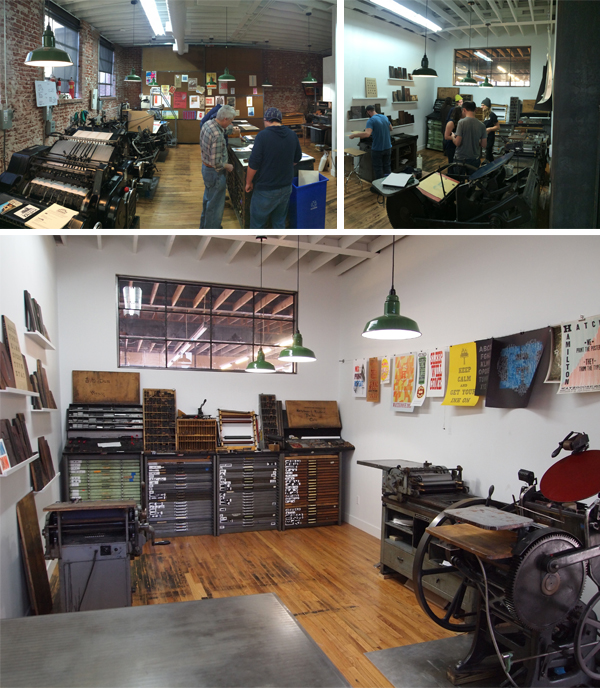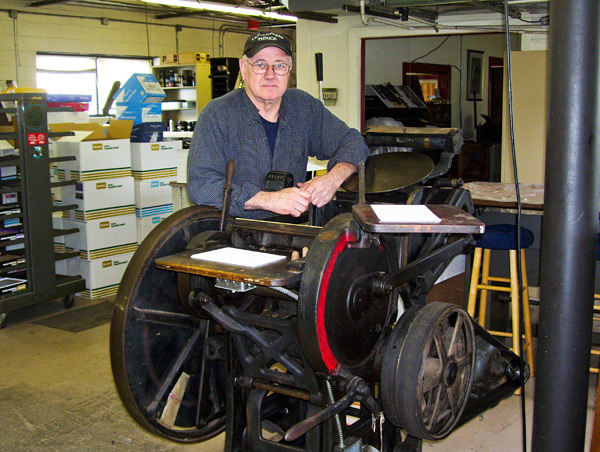A decade has passed and the creative gleam in Jason Wedekind’s eye still outshines even the brightest of metallic ink accent in his impressive printing portfolio. The Colorado-based printing realm of Genghis Kern has grown from two dozen cases of lead type & a single press to setting-up camp (and shop) in his dream workspace (not to mention acquiring a drool-worthy collection of hand-set and metal type). With one foot rooted in both the design & job world, Jason and his exceptionally gifted team have repeatedly pushed letterpress printing boundaries and amped up the creative oomph to their printed work. We stopped in to chat with Jason about the joys of printing, working with his mentor Tom Parsons, balancing life with two wonderful kids, and keeping up with the flow of community workshops.

(from left to right: Jason Wedekind and Jeff Shepherd of Genghis Kern)
DECADE OF PRINTING INGENUITY I founded Genghis Kern 10 years ago this May when I started printing for friends while working as an art director for a small design firm in Denver. I still remember the day when I bought my first press, leaving with 24 cases of lead type banging around in the back of my SUV and saying “what the hell did I just do? I don’t even know if I like this?!?!” I had been introduced into this wonderful world by Tom Parson, Denver’s poet/printer grandfather of letterpress, and founder of the Englewood Depot Letterpress Museum. The letterpress bug bit hard and hasn’t stopped biting yet. I spent many a night printing all sorts of fun stuff while learning the trade.

The firm I worked for got hit hard during 2009 and I was thrust into the world of self employment. With an 18month old daughter, it was stressful, but the payoff was rewarding. From day one it’s been a nice mix of design work and job work, with the goal being producing tactile work that makes both us and our clients proud. “One foot rooted in each world” is how a recent shop visitor described what we’ve built.
CREATIVE IN COLORADO Our current shop is my dream space. I drove by it in 1999 and said “That’d be a cool place to work” and now we do. It was a Hispanic Furniture and Record shop 2 blocks from my house. We have 2,000 square feet up front which we turned into a co-working space for creative types, and our 1,000 square foot print shop is in the back.

When I brought my current pressman/designer Jeff Shepherd on over a year ago, he mentioned he had a windmill in his folks’ garage. My garage shop was full to the gills at that time, but I knew growth was in our future. You see, I had moved my design arm of Genghis Kern out of my bedroom 2 years prior into a shared work space with 4 other creative firms. When I brought a pressman on, they worked in my garage and I ran back and forth the 5 blocks from the new “office” to the print shop. It worked, but grew tiresome. Let alone having to keep my house clean in case they needed to pee. I started looking for a new space that would allow us to combine a print shop and office space, and reached out to the owner of the furniture store blocks from my house. It had been vacant since 2005.
He agreed to my crazy plan and we broke ground in January of 2015, gutting the space and crossing our fingers that our floorplan for the pressroom would work out. Then the dominoes began to fall. We started with my original 10×15 C&P, an Asbern ADR-1 (German SP-15 Clone), a 10×15 Windmill, and a 30″ Challenge cutter. While doing the buildout Jeff saw a Heidlberg KSBA at auction that had inkers on it. My “dream” press. So we added that to the mix, quickly shuffling our floor plan to be to make room. Then one of the printers from our bimonthly printer’s lunch in Denver walked into our garage and said “Did you guys see that Vandercook for sale on the western slope?” Jeff ran inside and put an offer down on it. HIS dream press, a Vandercook 4.

We figured we’d deal with the floorplan when we had a floor to plan. SOON. So that became our current shop. We set the two proof presses up in our “type alley” where we host an occasional workshop. It’s fun having different presses to turn to when something goes south.
TL;DR: Our shop started out in my garage 10 years ago. 1 C&P and a cutter. I then moved 3 blocks and built my second “garage” shop, large enough to fit a C&P, Proof press (not yet owned), and a windmill (not yet owned), a stone and a cutter. What I neglected to tell my wife when we were designing the floor plan, was that if the presses were to move out one day, my dad’s vintage BMW motorcycle collection could slide right in where the presses once stood.

INTRIGUED BY LETTERPRESS While working as an art director back in 2003, someone brought in a beautiful custom duplexed letterpress/foil stamped card and said they wanted to add 3 initials to their name in 6pt. I looked at my print broker and asked “How the hell are we going to do that?” She told me letterpress. Hand-fed letterpress. I was intrigued. I knew of letterpress from the design annuals but had never been up close. That was about to change in a big way. I walked into the printshop of Tom Parson, our local “godfather” of letterpress and was transported to a different time. Tom printed that job and I said “I want a press (like every designer in the mid 2000s)” and he put me on the list. I asked him to teach me the process and he showed me how to do everything from hand washing plates to treadling. When it came time to print, he started kicking and I asked if I could try. He let me. The rest is history. I ended up kicking 600 cards in 40 minutes to which Tom asked “where did you learn how to do that?”. I told him my childhood was spent working in a decorating tool factory in Chicago, our family business which was started in 1908. Slave labor at its finest. But that slave labor instilled some hand eye coordination that I surely don’t complain about now.

FIRST PRESS 1922 10×15 C&P
PRINTING MENTORS Tom Parson will always be my first mentor, but my inspirations are the people out there pushing the boundaries and keeping the art of letterpress alive like Jen Farrell of Starshaped Press in Chicago. A day rarely goes by when I’m not wiping drool of my phone thanks to her instagram feed.
DESIGNED FOR PRINT I’m a designer and a printer. I’ve been hiring designers and printers. And we’re on a quest to turn some designers into printers. Feet in both worlds.
THE CREATIVE PROCESS My design process has been greatly influenced by the door that letterpress opened to the typographic world. Being faced with a design challenge and combining passions when applicable is the best feeling. Whether it be typographically or texturally, or both.

FULL TIME FUN, ALL YEAR ROUND Lately I’ve been printing a little more, but as the workload grows, I find myself printing less and less but enjoying the time in front of the presses even more. I’m also a member of the Amalgamated Printers Association, which is an incredible group of 150 printers from around the world who print 4x or more times a year. Each member gets a monthly envelope with everyone’s work in it. So creating for that keeps me on my toes and up to my elbows in type.
PRINTING FEATS I’m proud that I’ve been able to grow a business from a passion, and employ people with similar passions. I’m also proud to keep these ancient machines and type from the scrap heap. Those two kids I’m trying to instill a work ethic in before it’s too late? They make me proud on a daily basis. I think I complained more about “helping Dad” when I was their age. Eva and Jasper? Thanks for putting up with me!
BOXCAR’S ROLE The quality of Boxcar plates are unparalleled in my opinion. We have local photopolymer plate makers but letterpress isn’t their main focus. I know that if I get my artwork in on time, I’m going to get plates back quickly. And when there’s an issue with my plates, the help that the staff provides is top notch.

SHOP TIPS Embrace your local community. The amount of knowledge gained by the “olds” out there who aren’t getting younger, by the way, is invaluable. And most of them love sharing. If there’s no active community that you know of, start one by inviting over some old printers for coffee and donuts.
WHAT’S NEXT Just keep on organizing our new space. Offer a few more workshops. Streamline work flow. And continue to produce work we’re all proud of.
A huge round of applause (and thanks!) out to Jason of Genghis Kern for letting us get a sneak peek at his wonderfully creative printing world.



 ( image credit: USA Networks © 2009 )
( image credit: USA Networks © 2009 )














